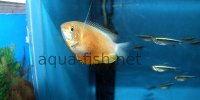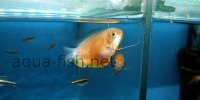Dwarf Gourami (Colisa lalia): Care, Breeding, and Feeding Guide
Quick Links
Brief Description
Colisa lalia, commonly known as the Dwarf Gourami, is a peaceful and vibrant freshwater fish. Native to Asia, particularly India and Pakistan, this species belongs to the gourami family, which is known for its flattened body and long, sensitive pelvic fin rays that help them navigate their environment. Dwarf Gouramis are popular among aquarists due to their gentle temperament and striking colors.
Introduction
Because they only grow to around 2 inches (~5cm), Dwarf gouramis are perfect for small tanks. They're an excellent choice for beginners due to their peaceful nature, easy care, and attractive appearance.
The difference between males and females is quite clear, thanks to their coloring. Male Dwarf gouramis are slightly larger than females and have striking turquoise and orange-red vertical bands across their body and fins. There are also color variations, such as males with a fully orange-red body and turquoise dorsal fin, or a mostly turquoise body with a bit of red along the fin edges. Females, in contrast, are silver with faint turquoise vertical stripes.
Colisa lalia can be kept in small groups or pairs, whether in species-only or community tanks. Males can become territorial, especially during breeding times, so it's recommended to keep just one male in smaller aquariums. Females, however, get along without issues.
Aquarium
Colisa lalia belongs to the anabantidae family, meaning they can breathe air directly thanks to their labyrinth organ. This organ developed because in their natural habitat, water often has low oxygen levels. Even in an aquarium with well-oxygenated water, they continue to breathe air since their gills aren't fully efficient. Due to this trait and the fact that they are good jumpers, it's recommended to use a tank with a secure lid.
If you're keeping one male and one or two females, a 10-gallon (~38 Liter, ~8.3 Imperial gallon) tank will suffice. Water temperature should be kept between 77° and 80° F (25°-27° C). They aren’t too demanding about water chemistry, so a pH of 6 to 7 and medium water hardness are ideal.
It's best to place the tank in a quiet area, as gouramis can become easily stressed by noise.
When setting up the aquarium, keep the following points in mind:
- Ensure a high number of plants. Colisa lalia naturally lives in plant-filled environments, which are important for nesting and helping them feel safe, especially for the often timid females.
- Be mindful of decorations. Sharp-edged rocks can damage the sensitive touch rays on their bellies, and Dwarf gouramis are curious by nature, so they may get stuck in decorations with small openings.
Additionally, using dark gravel can enhance the bright colors of the males, while females may appear nearly colorless on lighter gravel.
If you plan on keeping more than one male, a larger tank is necessary, ideally with other fish that can help diffuse territorial behaviors. In the wild, they often live with other gouramis like Colisa chuna and some trichogaster species, so creating a tank with an Asian fish theme could be a good option. Avoid fish that tend to nip at long fins, as they might damage the touch rays of the Colisa lalia.
Feeding
Colisa lalia are carnivores and generally have no trouble eating dry food. However, they are prone to constipation, so it’s crucial to feed them properly. Offer food once a day and make sure to have one day a week without feeding. It's best to feed them during calm periods when there’s minimal noise. If your fish are shy, try feeding them right before turning off the lights. Avoid flakes or low-quality dry food as these can cause their stomachs to swell.
The ideal diet includes jelly-preserved, frozen, and live foods. You can offer a variety like chironomus, daphnia, brine shrimp, earthworms, mealworms, fry, and more.
Breeding
Breeding Colisa lalia is relatively easy, similar to the process for Betta splendens, but there are a few important guidelines to follow:
- Set up a dedicated tank if you don’t already have one, with one male and one or two females. Dwarf gouramis build bubble nests, so they should be kept separate from a community tank to prevent the nest from being disturbed. Use a 5-gallon (~19 Liter, ~4.2 Imperial gallon) or larger tank without gravel or sand on the bottom. Include a good number of plants, with some floating and others in small pots. Ensure the tank is covered and has proper lighting, as dying plants can pollute the water and harm the fry. You’ll also need a heater and a filter - make sure to cover the intake with a small net or sponge to prevent fry from being sucked in.
- Choose young, healthy fish. It can be difficult to distinguish females ready to spawn as a bloated female might be mistaken for one full of eggs. This is why proper feeding is essential.
The breeding process can be broken down into these steps:
- Raise the temperature to 80°F (27°C) and lower the water level.
- The male will create a bubble nest using plants for support. Often, floating plants like Pistia stratiotes are used, with small plant bits incorporated into the bubbles, which are chewed and arranged by the male. At this stage, it's best to turn off the filter.
- After a few days of enriched feeding, including two meals per day with live or frozen foods, the female may be ready to spawn. The male will court her by swimming around and attempting to bring her beneath the nest. If she accepts, they’ll swim in circles before she touches the male’s body and fins with her mouth, signaling readiness to spawn.
- The pair will embrace multiple times. After each spawn, the male will gather the falling eggs and place them in the nest.
- If multiple females are in the tank, the male will mate with all of them. The spawning process usually lasts several hours, producing up to 500 eggs.
- Once spawning is complete, the male will cover the eggs with bubbles to prevent them from falling. At this point, all females should be removed, as the male may become aggressive in protecting the nest.
- In about two days, the fry will hatch, and after an additional three days, they’ll begin to swim. At this time, the male should be removed as he might eat the fry. Once the nest is no longer needed, you can turn the filter back on.
- During their early days, the fry should be fed infusoria and other small foods. Once they grow a bit, live baby brine shrimp is an excellent option. While dry food for fry is available in stores, they tend to prefer live food.
Thanks to Jose J. for allowing us to use his picture. Also, a big thanks to Cyberraga!
Copyright note: This article is originally written by Michela Ferretti. Aqua-fish.net owns the full copyright of this article.
Questions and Answers
Feel free to submit your own unique questions that haven't been addressed in this article yet. On March 24th, 2011, we added the following question here after merging aqua-fish.net/answers with related pages to provide all the information in one place.
What fish can be kept with a Dwarf gourami?
Answer: Dwarf gouramis should not be housed with aggressive tank mates. Suitable peaceful companions include Corydoras catfish, Bristlenose catfish, tetras, most livebearers, and plecos.




